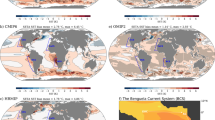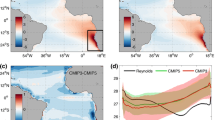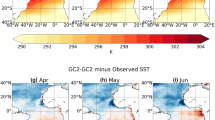Abstract
Many coupled ocean–atmosphere general circulation models (GCMs) suffer serious biases in the tropical Atlantic including a southward shift of the intertropical convergence zone (ITCZ) in the annual mean, a westerly bias in equatorial surface winds, and a failure to reproduce the eastern equatorial cold tongue in boreal summer. The present study examines an ensemble of coupled GCMs and their uncoupled atmospheric component to identify common sources of error. It is found that the westerly wind bias also exists in the atmospheric GCMs forced with observed sea surface temperature, but only in boreal spring. During this time sea-level pressure is anomalously high (low) in the western (eastern) equatorial Atlantic, which appears to be related to deficient (excessive) precipitation over tropical South America (Africa). In coupled simulations, this westerly bias leads to a deepening of the thermocline in the east, which prevents the equatorial cold tongue from developing in boreal summer. Thus reducing atmospheric model errors during boreal spring may lead to improved coupled simulations of tropical Atlantic climate.













Similar content being viewed by others
References
Biasutti M, Sobel AH, Kushnir Y (2006) AGCM precipitation biases in the tropical Atlantic. J Clim 19:935–958
Breugem W-P, Hazeleger W, Haarsma RJ (2006) Multimodel study of tropical Atlantic variability and change. Geophys Res Lett 33. doi:10.1029/2006GL027831
Chang P, Coauthors (2006) Climate fluctuations of tropical coupled system—the role of ocean dynamics. J Clim 19:5122–5174
Chang CY, Carton JA, Grodsky SA, Nigam S (2007), Seasonal climate of the tropical Atlantic sector in the NCAR community climate system model 3: error structure and probable causes of errors. J Clim 20:1053–1070
Cohen JC, Silva Dias MA, Nobre CA (1995) Environmental conditions associated with Amazonian squall lines: a case study. Mon Weather Rev 123:3163–3174
Conkright ME, Locarnini R, Garcia H, O’Brien T, Boyer TP, Stephens C, Antonov J (2002) World Ocean Atlas 2001, objective analyses, data statistics and figures, CD-ROM documentation, National Oceanographic Data Center. Silver Spring, MD
Davey MK, Coauthors (2002) STOIC: a study of coupled model climatology and variability in tropical ocean regions. Clim Dyn 18:403–420
Deser C, Capotondi A, Saravanan R, Phillips AS (2006) Tropical Pacific and Atlantic climate variability in CCSM3. J Clim 19:2451–2481
de Szoeke SP, Xie S-P (2008) The tropical eastern Pacific seasonal cycle: assessment of errors and mechanisms in IPCC AR4 coupled ocean–atmosphere general circulation models. J Clim (in press)
DeWitt DG (2005) Diagnosis of the tropical Atlantic near-equatorial SST bias in a directly coupled atmosphere-ocean general circulation model. Geophys Res Lett 32:L01703. doi:10.1029/2004GL021707
Dirmeyer PA, Koster RD, Guo Z (2006) Do global models properly represent the feedback between land and atmosphere? J Hydrometeor 7:1177–1198
Hagos SM, Cook KH (2005) Influence of Surface Processes over Africa on the Atlantic Marine ITCZ and South American Precipitation. J Clim 18:4993–5010
Hazeledger W, Haarsma RJ (2005) Sensitivity of tropical Atlantic climate to mixing in a coupled ocean–atmosphere model. Clim Dyn 25:387–399
Helber RW, Weisberg RH, Bonjean F, Johnson ES, Lagerloef GSE (2007) Satellite-derived surface current divergence in relation to tropical Atlantic SST and wind. J Phys Oceanogr 37:1357–1375
Huang B, Schopf PS, Shukla J (2004) Intrinsic ocean–atmosphere variability of the tropical Atlantic Ocean. J Clim 17:2058–2077
Huang B, Hu Z-Z, Jha B (2007) Evolution of model systematic errors in the tropical Atlantic basin from coupled climate hindcasts. Clim Dyn 28:661–682
Kalnay E, Coauthors (1996) The NCEP/NCAR 40-year reanalysis project. Bull Am Meteor Soc 77:437–471
Keenlyside NS, Latif M (2007) Understanding equatorial Atlantic interannual variability. J Clim 20:131–142
Klein SA, Hartmann DL (1993) The seasonal cycle of low stratiform clouds. J Clim 6:1587–1606
Kousky VE (1980) Diurnal rainfall variation in northeast Brazil. Mon Weather Rev 108:488–498
Large WG, Danabasoglu G (2006) Attribution and impacts of upper-ocean biases in CCSM3. J Clim 19:2325–2346
Ma CC, Mechoso CR, Robertson AW, Arakawa A (1996) Peruvian stratus clouds and the tropical pacific circulation: a coupled ocean—atmosphere GCM study. J Clim 9:1635–1645
Mechoso CR, Roberston AW Coauthors (1995) The seasonal cycle over the tropical Pacific in general circulation models. Mon Weather Rev 123:2825–2835
Meehl GA, Covey C, McAvaney B, Latif M, Stouffer RJ (2005) Overview of the coupled model intercomparison project. Bull Am Meteor Soc 86:89–93
Mesinger F, Janjić ZI, Ničković S, Gavrilov D, Deaven DG (1988) The step-mountain coordinate: model description and performance for cases of Alpine lee cyclogenesis and for a case of an Appalachian redevelopment. Mon Weather Rev 116:1493–1518
Mitchell TP, Wallace JM (1992) The annual cycle in equatorial convection and sea surface temperature. J Clim 5:1140–1156
Okumura Y, Xie S-P (2004) Interaction of the Atlantic equatorial cold tongue and African monsoon. J Clim 17:3588–3601
Okumura Y, Xie S-P (2006) Some overlooked features of tropical Atlantic climate leading to a new Nino-like phenomenon. J Clim 19:5859–5874
Repelli CA, Nobre P (2004) Statistical prediction of sea surface temperature over the tropical Atlantic. Int J Climatol 24:45–55
Richter I, Mechoso CR, Robertson AW (2008) What determines the position and intensity of the South Atlantic anticyclone in austral winter?—an AGCM study. J Clim 21:214–229
Rickenbach TM (2004) Nocturnal cloud systems and the diurnal variation of clouds and rainfall in southwestern Amazonia. Mon Weather Rev 132:1201–1219
Rossow WB, Schiffer RA (1999) Advances in understanding clouds from ISCCP. Bull Am Meteor Soc 80:2261–2287
Rouault M, Florenchie P, Fauchereau N, Reason CJC (2003) South East tropical Atlantic warm events and southern African rainfall. Geophys Res Lett 30. doi:10.1029/2002GL014840
Shannon LV, Boyd AJ, Brundrit GB, Taunton-Clark J (1986) On the existence of an El Niño type phenomenon in the Benguela system. J Mar Res 44:495–520
Stockdale TN, Balmaseda MA, Vidard A (2006) Tropical Atlantic SST prediction with coupled ocean–atmosphere GCMs. J Clim 19:6047–6061
Wang H, Fu R (2007) The influence of Amazon rainfall on the Atlantic ITCZ through convectively coupled Kelvin waves. J Clim 20:1188–1201
Worley SJ, Woodruff SD, Reynolds RW, Lubker SJ, Lott N (2005) ICOADS Release 2.1 data and products. Int J Climatol 25:823–842
Xie S-P (1996) Westward propagation of latitudinal asymmetry in a coupled ocean–atmosphere model. J Atmos Sci 53:3236–3250
Xie P, Arkin PA (1997) Global precipitation: a 17-year monthly analysis based on gauge observations, satellite estimates, and numerical model outputs. Bull Am Meteor Soc 78:2539–2558
Xie S-P, Carton JA (2004) Tropical Atlantic variability: patterns, mechanisms, and impacts. In: Earth climate: the ocean–atmosphere interaction. Geophys Monograph, vol 147. AGU, Washington DC, pp 121–142
Acknowledgments
This study was supported by the NOAA CLIVAR Program and the Japan Agency for Marine-Earth Science and Technology through its sponsorship of the International Pacific Research Center. All the model output was downloaded from The IPCC Data Archive at Lawrence Livermore National Laboratory, which is supported by the Office of Science, U.S. Department of Energy. The authors would like to thank Justin Small and two anonymous reviewers for their helpful suggestions. IPRC publication #498.
Author information
Authors and Affiliations
Corresponding author
Rights and permissions
About this article
Cite this article
Richter, I., Xie, SP. On the origin of equatorial Atlantic biases in coupled general circulation models. Clim Dyn 31, 587–598 (2008). https://doi.org/10.1007/s00382-008-0364-z
Received:
Accepted:
Published:
Issue Date:
DOI: https://doi.org/10.1007/s00382-008-0364-z




